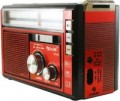—
FM. The most popular broadcasting range among radio listeners today is primarily due to the fact that the vast majority of music stations broadcast in it. This is due to its features: FM uses frequency modulation, which makes it possible to broadcast sound with a fairly high sound quality, and even in stereo format. In the frequency band, the term "FM" usually refers to the 87.5 MHz to 108 MHz portion of the VHF band, although the range of individual receivers may vary. The disadvantage of FM is the limited range — within the line of sight (up to several tens of kilometers), which has secured the reputation of "urban" stations for FM stations.
— AM. Formally, this designation is not a range, but a type of modulation: "amplitude modulation" — amplitude modulation. In consumer radios, AM most often means the medium wave range of about 520-1610 kHz. Such waves have a propagation range of hundreds of kilometers, but the sound quality in this case is somewhat worse than that of FM, and therefore the AM band is mainly used by radio stations of the “conversational” genre (for example, news or journalistic).
— SW. Broadcasting on short waves (short wave) in the general range from 2.5 MHz to 26.1 MHz, divided into a number of separate sub-bands. Sound quality is average. Short waves are able to reach the opposite side of the Earth, but immediately outside the line of sight of the transmitter, a “dead zone” is formed, several
...tens of kilometers wide. As a consequence, SW is commonly used for overseas broadcasts.
— DAB. Abbreviation for Digital Audio Broadcasting, i.e. "digital broadcasting". This term describes the key difference between this range and those described above: broadcasting in it is carried out not in analogue, but in digital format, the MP2 codec is used for transmission. This gives a number of advantages over traditional transmitters — in particular, a greater range with less power and high quality of the broadcast sound. In addition, this sound is practically not subject to distortion: weak interference does not affect its quality, and when the transmitter power is critically reduced, the signal is not distorted, but disappears entirely. The latter, however, can be written down as disadvantages; but the really significant drawback of this option is perhaps its low prevalence (so far) in the CIS countries. Technically, such broadcasting can be carried out in any band above 30 MHz, but in fact several options are used (depending on the country) related to the VHF band.
— DAB+. An updated and improved version of the DAB standard described above. It has all the characteristic features of digital broadcasting, and differs from its predecessor in higher sound quality at the same bit rates — both due to the use of a different codec (HE-AAC v2), and due to the use of more advanced noise correction algorithms. DAB+ broadcasts cannot be received on DAB receivers: at best, this will require a firmware update, and at worst, you will have to change the receiver itself.The type of connector used to charge the built-in battery, or more precisely, to connect an external charger. The role of such a device can be played by a network or car adapter, a power bank, or even a USB port of a PC or laptop (if the appropriate cable is available).
-
microUSB. A smaller version of the USB connector designed for portable devices. It appeared quite a long time ago, but does not lose popularity in our time, it is used by the vast majority of manufacturers.
-
USB C. A miniature USB connector, positioned, among other things, as a potential successor to microUSB. Unlike its predecessor, it has a double-sided design, thanks to which the plug can be inserted into the socket on either side. It is still relatively rare, but the situation is likely to change in the coming years.

